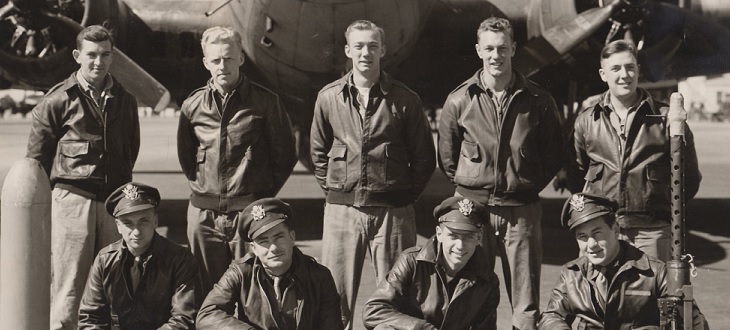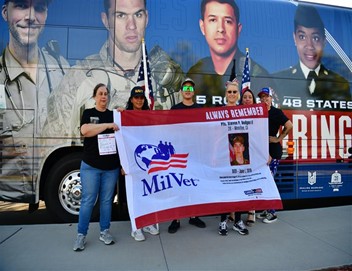John Clark, Robert James, Willard Johnson, Paul Young. These are the names of four men interred in four different national cemeteries. Though they now rest hundreds of miles apart with no relation immediately obvious, they are all connected through a single tragic event. One that occurred exactly 75 years ago today.
On the morning of June 21, 1944, 20 men boarded two B-17 Flying Fortress bombers in Norfolk, England. Both crews belonged to the 728th Bomb Squadron, 452nd Bomb Group. They had arrived at Deopham Green airfield in January and flew mostly strategic bombing missions over Germany. They also supported the D-Day invasions on the coast of Normandy.
Tech Sgt. John Clark, a twenty-year-old from Virginia, enlisted in the Army Air Forces after the United States entered World War II. He served as a radio operator on the B-17 numbered 42-102662 (#662). Serving alongside him on the #662 left waist gun was Ssgt Robert L. James, from Texas, and eight other men.
While the crew of the #662 prepared for departure, so did the crew of the B-17 “Little Colonel.” The tail gunner, Sgt. Willard Johnson conducted his pre-mission checks. He was a twenty-eight-year-old auto mechanic from Chicago and a first generation American born to Swedish parents. That morning he boarded the plane alongside a nineteen-year-old bombardier from Kentucky, 2nd Lt. Paul Young, and eight other crew members.
Both planes joined a bombing formation and took off over the North Sea headed towards Berlin. Their intended target was an aircraft engine factory. The group reached their target at about 10:30am and both #662 and “Little Colonel” released their bombs. During the mission, “Little Colonel” took some damage from flak but remained operable. The entire group turned and began heading towards the rally point designated a few miles Northwest of Berlin.
About ten minutes later, as the group approached the rally point, #662 and “Little Colonel” collided.
#662 made a right turn entering the path of “Little Colonel.” When the two planes made contact, #662’s tail broke off and entered into a tight spiral towards the ground. “Little Colonel,” already damaged by flak, broke apart.
A pilot from another bomber in formation observed #662 as it spiraled downwards about 20,000 feet before losing sight of it. He later noted that “it seemed impossible for anyone to bail out.”
Meanwhile, a few parachutes deployed from “Little Colonel” after breaking apart.
From the ground, German civilians, military, and police watched as the two planes came down near Rheinsberg. The rural police hurried to secure the crash site of #662 where they found one survivor, Ssgt. Edward Koster. Koster was a twenty-year-old from Rochester and served as the plane’s tail gunner. He was separated from the rest of #662 when the tail broke apart. He was taken prisoner and transported to the town of Neuruppin.
No other crew aboard the #662 survived. The remains of seven crewmen were found at or near the wreckage. One was taken to the nearby town of Beerenbusch where he was buried in the community cemetery the next day. The other six members were buried in Kleinzerlang’s municipal cemetery.
The two others from #662 were not discovered until later. German forces suspected that they may have attempted to escape. However, a German civilian discovered the remains of John Clark a few days later in a fir forest. A few weeks later, Robert James was found by a lake. Both were buried in the Beerenbusch cemetery.
Of the ten crew members of “Little Colonel,” only four survived. Two of them suffered broken right legs and another had received a cut on his head. They too were captured almost immediately after crashing and were taken to Neuruppin as prisoners joining Koster. The remaining crew of “Little Colonel” were buried in Beerenbusch alongside three of their comrades from #662.
In total, fifteen of twenty crew members perished that day. These are their names:
#662
- 2nd Lt. Edward B. Armm
- 2nd Lt. William H. Stooks
- 2nd Lt. Glen E. Swing
- Flt O. James E. Dozier
- Tech. Sgt. Arthur C. Kaule
- Sgt. Joseph J. Ostrander
- Ssgt. George A. Thut
- Tech. Sgt. John J. Clark
- Ssgt. Robert L. James
“Little Colonel”
- 2nd Lt. Richard F. Dean
- 2nd Lt. Paul S. Young
- Tech. Sgt. Frederick W. Thomas
- Tech Sgt. Edward J. McGrath
- Ssgt. Richard V. Graham
- Sgt. Willard N. Johnson
The five survivors taken prisoner were: Ssgt. Edward Koster, 2nd Lt. Harold Lerum, 2nd Lt. Melvin Van Gundy Jr., Sgt. George M. Slossman, and Sgt. Kenneth L. Salsbury.
After the war ended, efforts were made to recover the American remains buried overseas. The American Graves Registration Command (AGRC) launched an investigation in towns surrounding where #662 and “Little Colonel” went down to identify and locate all fifteen men who died that day. Through cooperation with local civilians, the AGRC were able to accurately locate all but one crew member: John Clark.
In 1945, as Soviet forces pushed into Germany, many Soviet soldiers were also buried in the Beerenbusch cemetery. When the war ended, they too attempted to return the remains of their service members home. Because Beerenbusch lied in Soviet territory after the war, the Soviet military disinterred graves at the cemetery first. According to the German civilians interviewed by AGRC, the identification bracelet and cross placed at John Clark’s grave went missing during the disinterment. Therefore, it was impossible to make a positive identification on his remains.
Today, Tech Sgt. John Clark has a memorial marker in Gerald B.H. Soloman Saratoga National Cemetery. Three other members of the #662 and “Little Colonel” also rest in one of our national cemeteries. Ssgt. Robert L. James is interred in Golden Gate National Cemetery. Sgt. Willard N. Johnson rests in Rock Island National Cemetery. And lastly, 2nd Lt. Paul Sweazy Young is buried in Zachary Taylor National Cemetery.
On this day, 75 years after these men perished, let us remember them. Join us in honoring them by sharing their stories, ensuring that their memories never fade and that their legacies never die.
Topics in this story
More Stories
Carry The Load, an organization dedicated to remembering the fallen, will visit 34 VA National Cemeteries traveling 20,000 miles along five separate routes covering all continental 48 states known as the National Relay for Memorial May 2024.
As part of the Veterans Legacy Program, NCA is awarding grants for a maximum of $400,000 per awardee to qualifying educational institutions and non-profit organizations (501c3).
VA is pleased to present the "2023 VA Federal Benefits Booklet for Veterans, Dependents, Survivors, and Caregivers," a thorough guide that explains the numerous benefits to Veterans, their families and caregivers.











PLEASE EXPLAIN MODERATION. I AM BRAIN DAMASGED AND DO NOT UNDERSTAND,
I AM A KOREAN WAR VETERAN. MY JOB WAS CRYPTOLOGIST AND SERVED ON TDY’S. BECAUSE OF MY DISPLACEMENTS I WAS NOT ABLE TO GET PICTURES FOR MY MEMORIES. I NOTICED THAT BEN SZALINSKI WHO WROTE A NUMBER OF STORIES AMONG WHICH HE HAD A WRITE UP OF RALPH PYLE JR WHO WAS THE PHOTOGRAPHER WITH THE 51ST SIGNAL BATTALION IN UIJONGBU (WHERE MASH 4077 WAS FILMED) 1951/52
RALPH JR IS NO LONGER ALIVE BUT HOPEFULLY BEN SZALINSKI MIGHT KNOW WHERE I COULD LOCATE
THE PHOTOS RALPH TOOK OR AT LEAST SOME.
I AM CORPORAL PAUL TENENBAUM AND LIVE IN FORT MYERS, FL
I APPRECIATE ANY KIND OF ASSISTANCE. THANK YOU